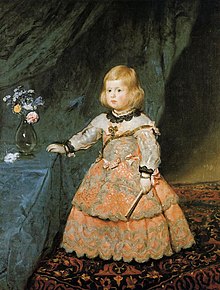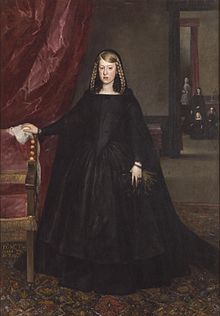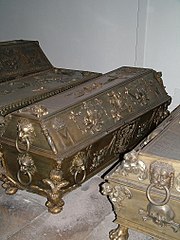Margarita Theresa of Spain



Margarita Theresa of Austria (Spanish: Margarita Teresa de Austria ) (* July 12, 1651 in Madrid ; † March 12, 1673 in Vienna ) was an Infanta of Spain from the Spanish line of the Habsburgs and Roman-German Empress. She was the first wife of Emperor Leopold I and sister of the last Spanish king of the House of Habsburg, Charles II of Spain .
Life
Margarita Theresa's parents were King Philip IV of Spain and his niece, Archduchess Maria Anna of Austria , who was almost thirty years his junior , who was called Mariana de Austria in Spain. Maria Anna was the daughter of Emperor Ferdinand III. and sister of Emperor Leopold. The mother of Maria Anna was again the younger sister of King Philip IV. The marriage of Philip IV and Maria Anna had six children, of which only two grew up, Margarita Teresa and the heir to the throne Karl . Margarita Teresa was her father's favorite child, who called her "my joy" in his letters. Unlike her younger brothers Philipp Prosper and Karl, Margarita did not suffer so much from the consequences of the incest that ruled between the Spanish and Austrian Habsburgs. As a child she was unusually often portrayed by Spanish painters, especially by Diego Velasquez , who she a. a. also depicted on his famous painting Las Meninas (1656, Prado, Madrid).
Margarita Theresa married her uncle and cousin Leopold I at the same time as part of the Habsburg marriage policy . The couple had been planned for a long time, and on this occasion the Madrid court had three paintings by Velázquez made over the years and sent to Vienna Show ages three, five and eight years. The paintings are now hanging in the Kunsthistorisches Museum in Vienna. The wedding took place - after long marriage negotiations - at Easter 1666 by procurationem (by proxy). Only in December of the same year did the Spanish bride arrive at the age of 15 in Vienna, where the official wedding was celebrated with great pomp. Antonio Cesti composed the opera “ Il pomo d'oro ” (The golden apple) especially for this occasion . For their performance, Leopold had his own theater built on the Cortina (the site of today's National Library, right next to the Vienna Hofburg ). This sumptuous nine-hour performance, which cost 100,000 guilders, was a topic of conversation across Europe for years. The musical emperor himself had written part of the opera for his bride. All in all, the wedding celebrations lasted all winter up to Lent, and a horse ballet with music by Johann Heinrich Schmelzer was also performed.
Margarita Teresa also called the emperor “uncle” during their marriage, while he said “Gretl” to her. She shared her husband's interest in music. The marriage was harmonious and in six years of marriage the Empress gave birth to six children (including two miscarriages), of which only one daughter, Maria Antonia (1669–1692), who later became the wife of Maximilian II. Emanuel , survived.
The young empress was of strict piety and is said to have induced Leopold I to expel the Jews from Vienna because she blamed them for their miscarriages . Margarita Teresa was very tender. She had suffered from goiter , a pathological change in the thyroid gland, since she was young .
Due to the aloofness and arrogance of the young empress's Spanish entourage, an anti-Spanish mood began to spread at court, which also turned against Margarita Teresa. The courtiers unabashedly expressed their hope that the ailing empress would soon die in order to pave the way for a second marriage for Leopold.

This unbearable situation put a great strain on Margarita Teresa and shortly after the birth of her sixth child, she died weak from the many pregnancies at the age of only 21. She is one of the 41 people who received a " separate burial " with the body being divided between all three traditional Viennese burial sites of the Habsburgs ( imperial crypt , heart crypt , ducal crypt ).
Her claim to the Spanish inheritance was passed on to Emperor Leopold I. Since Margarita Teresa, in contrast to her half-sister María Teresa (1638–1683), who was married to King Louis XIV of France, did not demand renunciation of the Spanish inheritance, Leopold I later based his claim on this marriage as part of the War of the Spanish Succession Spain.
progeny
In her marriage to Leopold I , she gave birth to the following children:
- Ferdinand Wenzel (September 28, 1667 - January 13, 1668)
- Maria Antonia (January 18, 1669 - December 24, 1692) ⚭ 1685 Elector Maximilian II. Emanuel of Bavaria
- Johann Leopold (* / † February 20, 1670)
- Maria Anna Antonie (February 9, 1672 - February 23, 1672)
ancestors
| Philip II (Spain) (1527–1598) | |||||||||||||
| Philip III (Spain) (1578-1621) | |||||||||||||
| Anna of Austria (1549–1580) | |||||||||||||
| Philip IV (Spain) (1605–1665) | |||||||||||||
| Charles II (Inner Austria) (1540–1590) | |||||||||||||
| Margaret of Austria (1584–1611) | |||||||||||||
| Maria Anna of Bavaria (1551–1608) | |||||||||||||
| Margarita Teresa of Spain (1651–1673) | |||||||||||||
| Ferdinand II (HRR) (1578-1637) | |||||||||||||
| Ferdinand III. (HRR) (1608-1657) | |||||||||||||
| Maria Anna of Bavaria (1574-1616) | |||||||||||||
| Maria Anna of Austria (1634-1696) | |||||||||||||
| Philip III (Spain) (1578-1621) | |||||||||||||
| Maria Anna of Spain (1606–1646) | |||||||||||||
| Margaret of Austria (1584–1611) | |||||||||||||
literature
- Gigi Beutler: The Imperial Crypt . Vienna 1998.
- Brigitte Hamann : The Habsburgs - A biographical lexicon . Ueberreuter Verlag, Vienna 1988.
- Konrad Kramar, Petra Stuiber: The quirky Habsburgs - quirks and airs of an imperial family . Ueberreuter Verlag, Vienna 1999, ISBN 3-8000-3742-4 .
- Irmgard Smidt-Dörrenberg: Margarita Maria. Velázquez's loveliest model . Bergland-Verlag, Vienna 1966.
- Alfred A. Strnad: Margarethe, Infanta of Spain. In: New German Biography (NDB). Volume 16, Duncker & Humblot, Berlin 1990, ISBN 3-428-00197-4 , pp. 155-157 ( digitized version ).
- Helga Widorn: The Spanish wives of Emperor Maximilian II, Ferdinand III. and Leopold I. dissertation, Vienna 1959.
- Richard Reifenscheid: The Habsburgs: From Rudolf I. to Karl I. Weltbild, Vienna 1982.
Web links
- Entry on Margarita Theresa of Spain in the Austria Forum (in the AEIOU Austria Lexicon )
- Description of the horse ballet on the occasion of the wedding of Margarita Teresa of Spain with Emperor Leopold I in the Vienna Hofburg in 1667 ( Memento from March 4, 2016 in the Internet Archive )
Footnotes
- ↑ Ernst Walter Zeeden : Hegemonic wars and religious struggles 1556–1648 (= Propylaea history of Europe. Volume 2). Propylaen Verlag, Berlin 1977, ISBN 3-549-05792-4 , pp. 400-401.
- ^ Karl Vocelka : The private world of the Habsburgs . Styria premium Verlag, Graz 1998, p. 274.
- ↑ Leopold was - like many Habsburgs - pious himself; he was originally brought up for a spiritual career and only became emperor because his older brother Ferdinand IV died too early (1654).
| predecessor | Office | Successor |
|---|---|---|
| Eleonora Magdalena Gonzaga of Mantua-Nevers |
Holy Roman Empress from Easter 1666 to March 12, 1673 |
Claudia Felizitas from Austria-Tyrol |
| personal data | |
|---|---|
| SURNAME | Margarita Theresa of Spain |
| ALTERNATIVE NAMES | Austria, Margarita Teresa de |
| BRIEF DESCRIPTION | Spanish princess, Holy Roman Empress |
| DATE OF BIRTH | July 12, 1651 |
| PLACE OF BIRTH | Madrid |
| DATE OF DEATH | March 12, 1673 |
| Place of death | Vienna |
